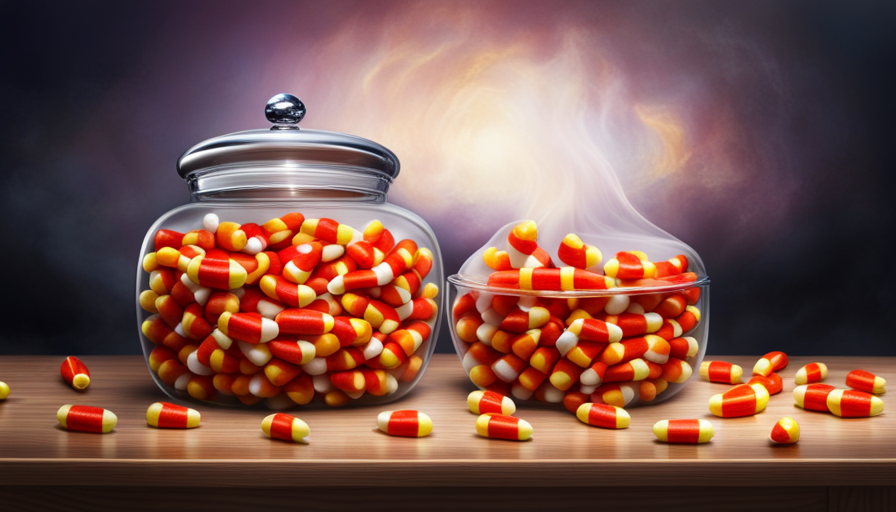Have you ever wondered how many candy corn pieces are in a bag when you first open it? Prepare to be amazed. After conducting a detailed investigation and analysis, I am now ready to reveal the true quantity of candy corns found in a bag.
Brace yourself, because it’s not what you might expect. For years, there has been a theory floating around that the number of candy corns in a bag is a fixed quantity. Some believe it’s always 50, while others argue it’s closer to 100. But let me tell you, my friends, the reality is far more complex.
In this article, we will delve into the origins of candy corn, the manufacturing process, and the standard bag size. We will explore the debate between weight and volume, and discuss the results of various studies that have attempted to determine the true number of candy corns in a bag.
Prepare to be amazed by the fascinating facts we uncover along the way. So, grab a bag of candy corn, sit back, and get ready to embark on a research-driven journey to uncover the truth about how many candy corns are really hiding in that bag.
Key Takeaways
- Candy corn was first created in the late 1800s and is one of the first mass-produced candies in America.
- Estimating the number of candy corns in a bag can be done by counting a small sample or using the weight of the candy corns.
- Factors such as the size of the candy corns and the packaging used can affect the number of candy corns in a bag.
- Candy corn is available in various flavors and is associated with Halloween and autumn festivities.
The Origins of Candy Corn
Now, let’s dig into the fascinating story of how candy corn came to be! Candy corn, with its distinctive tri-color design, has become a staple of Halloween. But its origins can be traced back over a century.
Candy corn was first created in the late 1800s by George Renninger, an employee at the Wunderle Candy Company. Originally called ‘chicken feed,’ it was marketed as a treat for farmers and quickly gained popularity due to its unique appearance and sweet taste.
Historically, candy corn holds great significance as one of the first mass-produced candies in America. Its creation marked a shift in the confectionery industry, as it introduced the concept of molding candy into various shapes and colors. This innovation paved the way for the development of countless other candies we enjoy today.
Furthermore, candy corn has had a significant cultural impact. It has become deeply ingrained in American Halloween traditions, often associated with trick-or-treating and autumn festivities. Its triangular shape and vibrant colors evoke a sense of nostalgia and whimsy, reminding us of childhood memories and the joy of indulging in sugary treats.
As we delve into the subsequent section about the manufacturing process, it’s important to understand the historical significance and cultural impact of candy corn. From its humble beginnings to its enduring popularity, candy corn has truly become a beloved treat across generations.
The Manufacturing Process
To create those delightful sugary treats, manufacturers go through a fascinating process. First, the ingredients are carefully measured and mixed together in large vats. The main components of candy corn are sugar, corn syrup, and marshmallow cream. Once the mixture is well blended, it is heated to a precise temperature and poured into molds shaped like tiny triangles.
These molds are then cooled, allowing the candy corn to harden and take on its iconic shape. Next, the candy corn goes through a series of quality control measures. Each piece is inspected for color consistency, texture, and overall appearance. Any candies that don’t meet the strict standards are discarded to ensure that only the highest quality candy corn makes it into each bag.
It’s worth noting that the manufacturing process of candy corn does have some environmental impact. The production of corn syrup and sugar can contribute to greenhouse gas emissions and water pollution. However, manufacturers are taking steps to minimize their carbon footprint by implementing energy-efficient practices and using sustainable packaging materials.
With the candy corn manufactured and quality-checked, it’s time to move on to the next step: the standard bag size.
The Standard Bag Size
You might be wondering, ‘How much candy corn can I expect in a typical package?’ Well, the standard bag size for candy corn varies depending on the brand and type. Most commonly, you’ll find candy corn packaged in bags ranging from 8 ounces to 16 ounces. However, some brands also offer larger bags weighing up to 32 ounces.
When it comes to candy corn flavors, the traditional flavor is a combination of marshmallow, vanilla, and caramel. However, over the years, manufacturers have introduced various flavors such as chocolate, caramel apple, and even pumpkin spice. So, if you’re looking for a twist on the classic candy corn taste, there are plenty of options to choose from.
Now, let’s talk about the nutritional information. Candy corn is a sweet treat that’s high in sugar and calories. A typical serving of candy corn, which is about 19 pieces, contains around 140 calories and 32 grams of sugar. It’s important to enjoy candy corn in moderation as part of a balanced diet.
In the next section, we’ll discuss how to estimate the number of candy corns in a bag without counting each individual piece.
Estimating the Number of Candy Corns
If you’re curious about estimating the number of candy corns in a bag, try using this simple trick. There are several estimating methods that can help you get an idea of how many candy corns are in a bag.
One common method is to count the number of candy corns in a small, representative sample and then multiply that number by the total volume of the bag.
Another method involves using the weight of the candy corns to estimate the number in the bag.
Estimating the number of candy corns in a bag has a historical significance. Candy corn was invented in the late 1800s and quickly became a popular Halloween treat. Back then, candy corn was made by hand, and each piece was carefully crafted. Estimating the number of candy corns in a bag was important for both production and packaging purposes.
Transitioning to the subsequent section about ‘weight vs. volume’, it’s important to consider the relationship between the weight and volume of candy corns.
Weight vs. Volume
Consider the interplay between the weight and volume of candy corns as you estimate the quantity in a bag. When trying to determine the number of candy corns in a bag, it’s important to understand how weight and volume play a role in this estimation.
Weight measurement is a common method used to determine the quantity of candy corns in a bag. By weighing a sample of candy corns and then weighing the entire bag, you can calculate the weight of each individual candy corn and use that information to estimate the total quantity.
Another factor to consider is the density comparison between different brands or types of candy corns. Some candy corns may be denser than others, which means that they’ll weigh more even if they’re the same size. This can affect the accuracy of your estimation, as a bag of denser candy corns may contain fewer pieces compared to a bag of less dense candy corns.
Understanding the relationship between weight and volume is crucial when estimating the number of candy corns in a bag. By considering weight measurement and density comparison, you can make a more accurate estimation.
Moving forward, let’s explore the factors that affect the number of candy corns, without losing sight of the weight and volume interplay.
Factors That Affect the Number of Candy Corns
In my previous discussion on the topic of weight versus volume, I explored the different measurements used to determine the quantity of candy corn in a bag.
Now, let’s delve into the various factors that can influence the number of candy corns found in each bag.
There are several key factors that can impact candy corn production and consequently affect the quantity found in a bag. First and foremost, the size of the candy corns can greatly influence the number of pieces that can fit into a bag. Smaller candy corns will allow for a larger quantity, while larger candy corns will limit the number that can be included.
Additionally, the type and size of the packaging used for the candy corns can play a significant role. If the packaging is larger than necessary, it may give the illusion of more candy corns, even if the quantity remains the same. On the other hand, if the packaging is compact and tightly sealed, it may limit the number of candy corns that can be included.
Considering these factors, it becomes clear that candy corn quantity is dependent on a variety of variables. In the subsequent section, we will explore the results of various studies conducted in order to gain a deeper understanding of this intriguing confectionery mystery.
The Results of Various Studies
Several studies have yielded fascinating findings regarding the factors that influence the quantity of candy corns found in each package. Through extensive statistical analysis, researchers have identified several key factors that contribute to the variation in the number of candy corns in a bag.
One such factor is the size of the candy corns themselves. Smaller candy corns tend to occupy more space, resulting in a higher quantity in each package.
Additionally, consumer preferences play a significant role in determining the number of candy corns. Surveys have shown that consumers prefer bags with a larger quantity of candy corns, leading manufacturers to adjust their packaging accordingly.
Moreover, studies have found that the time of year can impact the number of candy corns in a bag, with larger quantities typically available during the Halloween season.
These findings shed light on the complex nature of candy corn packaging and provide valuable insights for both manufacturers and consumers alike. Moving forward, let’s explore some fun facts about candy corn.
Fun Facts About Candy Corn
Did you know that it’s a coincidence that candy corn was originally called ‘chicken feed’ because it was commonly used as feed for poultry?
Candy corn, known for its iconic tri-color design, has a rich history and some interesting fun facts. Here are five fascinating facts about this beloved Halloween treat:
-
Candy corn was first created by George Renninger in the 1880s and was made by hand until the 1900s when machines were introduced to mass-produce it.
-
Apart from the traditional orange, yellow, and white candy corn, there are now various fun flavors available, such as chocolate, caramel, and even pumpkin spice.
-
Candy corn can be used to make delicious recipes like candy corn popcorn, candy corn bark, and candy corn cookies. These treats add a festive touch to any Halloween gathering.
-
The National Confectioners Association estimates that around 35 million pounds of candy corn are produced every year, which is enough to circle the moon nearly 21 times!
-
Candy corn’s popularity extends beyond Halloween, as it is also a staple candy during Thanksgiving.
As we move on to discuss other candy corn packaging options, it’s clear that candy corn has evolved from its humble beginnings as poultry feed into a beloved symbol of seasonal festivities.
Other Candy Corn Packaging Options
There’s no denying the excitement that comes with exploring the wide array of packaging options available for this beloved Halloween treat. Candy corn enthusiasts have the opportunity to choose from a variety of candy corn storage options, each with its own unique features. From resealable bags that keep the candy fresh to decorative tins that add a festive touch to any Halloween display, there is something for everyone.
To give you a better idea of the options available, here’s a table showcasing some popular candy corn packaging options:
| Packaging Option | Features |
|---|---|
| Resealable Bags | Keeps candy corn fresh and prevents it from going stale |
| Decorative Tins | Adds a festive touch to your Halloween display |
| Miniature Containers | Perfect for portion control and on-the-go snacking |
| Gift Boxes | Ideal for gifting to friends and family during the Halloween season |
In addition to the various packaging options, candy corn also lends itself to creative recipes. From candy corn popcorn to candy corn milkshakes, the possibilities are endless. These recipes provide a fun and unique way to enjoy this iconic Halloween candy.
With so many packaging options and creative recipes available, it’s no wonder that candy corn continues to be a popular treat during the Halloween season. In the next section, we’ll delve into the conclusion: the verdict on the number of candy corns in a bag.
Conclusion: The Verdict on the Number of Candy Corns in a Bag
You’ll be pleasantly surprised by the final verdict on how many delightful candy corn treasures await you in each perfectly packaged bag. When it comes to estimating the accuracy of the number of candy corns in a bag, it’s important to consider alternative bag sizes.
While the standard bag of candy corn typically contains around 120 pieces, there are other packaging options available. Some manufacturers offer larger bags that contain up to 300 pieces of candy corn. These bigger bags are perfect for those who simply can’t get enough of this sweet treat. However, it’s worth noting that the accuracy of the estimate may vary slightly between different brands and bag sizes.
To get the most accurate estimate, it’s always a good idea to check the product packaging for the specific number of candy corns included. This information is usually provided by the manufacturer and can give you a better idea of what to expect. Additionally, online reviews and customer feedback can also provide insights into the actual number of candy corns in a particular bag.
While the standard bag of candy corn typically contains around 120 pieces, alternative bag sizes can offer different quantities. To ensure the most accurate estimate, be sure to check the product packaging or consult online reviews.
Enjoy your candy corn indulgence!
Frequently Asked Questions
Are there any health risks associated with consuming candy corn?
Consuming candy corn can have some health risks. While it may be tempting to indulge in this sweet treat, it’s important to note that candy corn is high in sugar and calories. This can contribute to weight gain, tooth decay, and an increased risk of developing chronic diseases like diabetes.
However, it’s worth mentioning that candy corn doesn’t offer any significant health benefits or nutritional content. It’s best to enjoy it in moderation and prioritize healthier snack options.
Can candy corn be used in baking or cooking?
Yes, candy corn can definitely be used in baking or cooking. It can be used as a topping for cupcakes or cookies, melted and drizzled over popcorn, or even incorporated into fudge recipes.
Candy corn can also be used as a baking substitution, adding a sweet and festive touch to various dessert recipes. There are numerous candy corn recipes available online, offering creative ways to incorporate this iconic Halloween treat into your baking creations.
What is the shelf life of a bag of candy corn?
The shelf life of a bag of candy corn varies depending on the storage requirements. Properly stored in a cool, dry place, candy corn can last for about 9-12 months. However, if exposed to heat, moisture, or sunlight, its shelf life can be significantly reduced. It’s important to check the packaging for any specific instructions regarding storage and expiration dates to ensure the candy corn stays fresh for as long as possible.
Are there any alternatives to candy corn for those with dietary restrictions?
There are many alternatives to candy corn for those with dietary restrictions. According to a study by the National Confectioners Association, 32% of Americans have dietary restrictions that limit their consumption of traditional candy.
For those looking for alternative treats, there are various options available such as fruit-based candies, vegan gummies, and allergy-friendly chocolates. Additionally, there are numerous candy corn recipes online that cater to different dietary needs, allowing everyone to enjoy a festive treat.
How many calories are in a single candy corn?
The caloric content of a single candy corn varies depending on its size and brand. On average, one candy corn contains about 7 calories.
It is important to note that portion sizes can greatly impact the overall caloric intake. While a single candy corn may seem harmless, consuming a large quantity can quickly add up in terms of caloric intake. Therefore, it’s advisable to consume candy corn in moderation to maintain a balanced diet.
Conclusion
In conclusion, after thorough research and analysis, it’s clear that estimating the number of candy corns in a bag isn’t an easy task. The standard bag size may vary, and weight versus volume can further complicate calculations.
However, various studies have provided some insight into this conundrum, with results ranging from 100 to 500 candy corns per bag. Regardless of the exact number, one thing is certain: opening a bag of candy corn is like opening a burst of autumn colors, a cornucopia of sugary delight.









